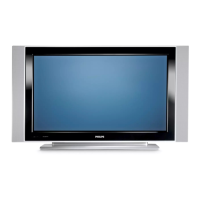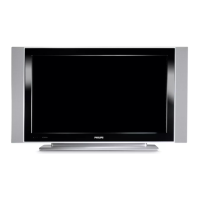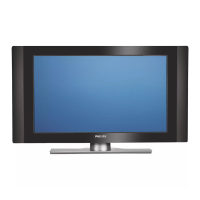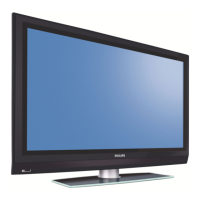Do you have a question about the Philips 37PFL4007T/12 and is the answer not in the manual?
Overview of TV features including HD, Smart TV, media playback, and EasyLink.
Using the TV as a digital hub, connecting to home networks and the internet.
Functions and buttons of the TV's remote control.
Essential safety precautions to prevent injury, fire, or damage.
Procedures and contact information for Philips customer support.
Basic operations for viewing television channels.
Connecting and switching between different input devices.
Optimizing picture and sound using predefined or custom settings.
Steps to establish an internet connection for the TV.
Navigating and managing applications within the Smart TV platform.
Temporarily stopping and resuming live TV broadcasts.
Setting up a USB hard drive for TV recording and pausing.
Recording current or future TV programmes onto a USB hard drive.
Methods for starting immediate or scheduled TV recordings.
Advanced HDMI-CEC features for controlling connected devices.
Adjusting picture and sound settings using assistants and menus.
Installing, searching, and managing TV channels.
Activating features for hearing or visually impaired users.
Checking for and installing TV software updates via USB, broadcast, or internet.
Details on HDMI connections for best picture and sound quality.
Overview of connecting to networks for media streaming and online services.
Steps for connecting the TV to a home network using an Ethernet cable.
Connecting the TV wirelessly using a USB adapter or built-in Wi-Fi.
Guide to connecting the TV wirelessly to a home network.
Solutions for common problems like TV not switching on or responding.
Troubleshooting problems related to channel installation and reception.
Solutions for distorted, missing, or improperly fitting pictures.
Troubleshooting poor sound quality or no sound output.
Resolving problems with HDMI devices and EasyLink functionality.
Diagnosing and fixing slow or unstable network and Smart TV performance.
Procedures and contact information for obtaining Philips support.
Technical details on power consumption, input signals, and reception bands.
Specifications for screen type, size, resolution, and audio output.
Supported multimedia file formats, connections, and codecs.
Overview of TV features including HD, Smart TV, media playback, and EasyLink.
Using the TV as a digital hub, connecting to home networks and the internet.
Functions and buttons of the TV's remote control.
Essential safety precautions to prevent injury, fire, or damage.
Procedures and contact information for Philips customer support.
Basic operations for viewing television channels.
Connecting and switching between different input devices.
Optimizing picture and sound using predefined or custom settings.
Steps to establish an internet connection for the TV.
Navigating and managing applications within the Smart TV platform.
Temporarily stopping and resuming live TV broadcasts.
Setting up a USB hard drive for TV recording and pausing.
Recording current or future TV programmes onto a USB hard drive.
Methods for starting immediate or scheduled TV recordings.
Advanced HDMI-CEC features for controlling connected devices.
Adjusting picture and sound settings using assistants and menus.
Installing, searching, and managing TV channels.
Activating features for hearing or visually impaired users.
Checking for and installing TV software updates via USB, broadcast, or internet.
Details on HDMI connections for best picture and sound quality.
Overview of connecting to networks for media streaming and online services.
Steps for connecting the TV to a home network using an Ethernet cable.
Connecting the TV wirelessly using a USB adapter or built-in Wi-Fi.
Guide to connecting the TV wirelessly to a home network.
Solutions for common problems like TV not switching on or responding.
Troubleshooting problems related to channel installation and reception.
Solutions for distorted, missing, or improperly fitting pictures.
Troubleshooting poor sound quality or no sound output.
Resolving problems with HDMI devices and EasyLink functionality.
Diagnosing and fixing slow or unstable network and Smart TV performance.
Procedures and contact information for obtaining Philips support.
Technical details on power consumption, input signals, and reception bands.
Specifications for screen type, size, resolution, and audio output.
Supported multimedia file formats, connections, and codecs.
| Screen Size | 37 inches |
|---|---|
| Resolution | 1920 x 1080 pixels |
| Display Technology | LCD |
| HDMI Ports | 3 |
| USB Ports | 2 |
| Audio Output | 2 x 10 W |
| Brightness | 400 cd/m² |
| 3D | No |
| Built-in speaker(s) | Yes |
| Number of speakers | 2 |
| RMS rated power | 20 W |
| USB 2.0 ports quantity | 2 |
| Component video (YPbPr/YCbCr) in | 1 |
| SCART ports quantity | 1 |
| Common interface (CI) | Yes |
| Common interface Plus (CI+) | Yes |
| Digital audio optical out | 1 |
| Ethernet LAN | Yes |
| Wi-Fi | No |
| VESA mounting | Yes |
| VESA mounting interfaces | 200 x 200 mm |
| Weight | 12.5 kg |
| Aspect Ratio | 16:9 |
| Energy Efficiency Class | A |
| Digital signal format system | DVB-T, DVB-C |
| Screen format adjustments | 16:9, 4:3, Zoom |
| Supported video modes | 1080p, 720p, 576p, 576i, 480p, 480i |
| Depth (with stand) | 220 mm |











